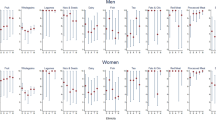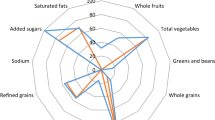Abstract
Background:
Socio-economic factors may affect diet quality, perhaps differentially across gender and ethnicity. The mechanism of this association is still largely unknown.
Objectives:
We examined the independent effects of socio-economic status (SES), perceived barrier of food price (PBFP) and perceived benefit of diet quality (PBDQ) on diet quality indicators and indices (DQIj,k), across gender and ethnicity. Additionally, we estimated the mediation proportion of the effect of SES on DQIj,k through PBFP and PBDQ.
Methods:
Data from two cross-sectional surveys, the Continuing Survey of Food Intakes by Individuals (CSFII) and Diet and Health Knowledge Survey (DHKS) 1994–96 were used. Our sample consisted of 4356 US adults aged 20–65 years. With principal components analysis, SES (an index) was measured using household income per capita and education, and PBDQ was measured using an 11-item scale. PBFP was defined as the ratio of importance of food price score relative to nutrition. DQIj,k were assessed by a set of indicators and two indices including the Healthy Eating Index.
Results:
The associations between SES, PBFP, PBDQ and DQIj,k varied significantly across gender and ethnic groups. PBFP acted as a mediator in the association between SES and selected DQIj indicators, namely energy, fat intake, sodium and simple sugar consumption (mediation proportion >10%), but not PBDQ.
Conclusions:
SES, PBFP and PBDQ all affect dietary intake, and vary by ethnicity and gender. Positive effect of SES on DQIj,k may be mediated by PBFP but not PBDQ which is an independent protective factor. Nutrition education is important to promote healthy eating.
This is a preview of subscription content, access via your institution
Access options
Subscribe to this journal
Receive 12 print issues and online access
$259.00 per year
only $21.58 per issue
Buy this article
- Purchase on Springer Link
- Instant access to full article PDF
Prices may be subject to local taxes which are calculated during checkout



Similar content being viewed by others
References
Appel LJ (2000). The role of diet in the prevention and treatment of hypertension. Curr Atheroscler Rep 2, 521–528.
Bender R, Lange S (2001). Adjusting for multiple testing – when and how? J Clin Epidemiol 54, 343–349.
Bodnar LM, Siega-Riz AM (2002). A Diet Quality Index for Pregnancy detects variation in diet and differences by sociodemographic factors. Public Health Nutr 5, 801–809.
Bowman SA, Vinyard BT (2004). Fast food consumption of US adults: impact on energy and nutrient intakes and overweight status. J Am Coll Nutr 23, 163–168.
Byrne B (2001). Structural Equation Modeling with Amos: Basic Concepts, Applications, and Programming. USA.
Dennis LK, Snetselaar LG, Nothwehr FK, Stewart RE (2003). Developing a scoring method for evaluating dietary methodology in reviews of epidemiologic studies. J Am Diet Assoc 103, 483–487.
Ding EL, Mozaffarian D (2006). Optimal dietary habits for the prevention of stroke. Semin Neurol 26, 11–23.
Ditlevsen S, Christensen U, Lynch J, Damsgaard MT, Keiding N (2005). The mediation proportion: a structural equation approach for estimating the proportion of exposure effect on outcome explained by an intermediate variable. Epidemiology 16, 114–120.
Drewnowski A (2004). Obesity and the food environment: dietary energy density and diet costs. Am J Prev Med 27, 154–162.
Drewnowski A, Darmon N (2005a). The economics of obesity: dietary energy density and energy cost. Am J Clin Nutr 82, 265S–273S.
Drewnowski A, Darmon N (2005b). Food choices and diet costs: an economic analysis. J Nutr 135, 900–904.
Ford ES, Mokdad AH, Liu S (2005). Healthy Eating Index and C-reactive protein concentration: findings from the National Health and Nutrition Examination Survey III, 1988–1994. Eur J Clin Nutr 59, 278–283.
Friel S, Kelleher CC, Nolan G, Harrington J (2003). Social diversity of Irish adults nutritional intake. Eur J Clin Nutr 57, 865–875.
Fung TT, McCullough ML, Newby PK, Manson JE, Meigs JB, Rifai N et al. (2005). Diet-quality scores and plasma concentrations of markers of inflammation and endothelial dysfunction. Am J Clin Nutr 82, 163–173.
Giskes K, Lenthe Fv F, Brug HJ, Mackenbach J (2004). Dietary intakes of adults in the Netherlands by childhood and adulthood socioeconomic position. Eur J Clin Nutr 58, 871–880.
Gittelsohn J, Anliker JA, Sharma S, Vastine AE, Caballero B, Ethelbah B (2006). Psychosocial determinants of food purchasing and preparation in American Indian households. J Nutr Educ Behav 38, 163–168.
Greenland S, Robins JM (1991). Empirical-Bayes adjustments for multiple comparisons are sometimes useful. Epidemiology 2, 244–251.
Groth MV, Fagt S, Brondsted L (2001). Social determinants of dietary habits in Denmark. Eur J Clin Nutr 55, 959–966.
Guo X, Warden BA, Paeratakul S, Bray GA (2004). Healthy Eating Index and obesity. Eur J Clin Nutr 58, 1580–1586.
Hatcher L (1994). A step-by-step approach to using the SAS system for factor analysis ad structural equation modeling,. SAS, Cary, NC.
Hulshof KF, Brussaard JH, Kruizinga AG, Telman J, Lowik MR (2003). Socio-economic status, dietary intake and 10 y trends: the Dutch National Food Consumption Survey. Eur J Clin Nutr 57, 128–137.
Inglis V, Ball K, Crawford D (2005). Why do women of low socioeconomic status have poorer dietary behaviours than women of higher socioeconomic status? A qualitative exploration. Appetite 45, 334–343.
Kant AK, Schatzkin A, Graubard BI, Schairer C (2000). A prospective study of diet quality and mortality in women. JAMA 283, 2109–2115.
Kaufman JS, MacLehose RF, Kaufman S, Greenland S (2005). The mediation proportion. Epidemiology 16, 710.
Kennedy ET, Bowman SA, Spence JT, Freedman M, King J (2001). Popular diets: correlation to health, nutrition, and obesity. J Am Diet Assoc 101, 411–420.
Mai V, Kant AK, Flood A, Lacey Jr JV, Schairer C, Schatzkin A (2005). Diet quality and subsequent cancer incidence and mortality in a prospective cohort of women. Int J Epidemiol 34, 54–60.
McCullough ML, Feskanich D, Rimm EB, Giovannucci EL, Ascherio A, Variyam JN et al. (2000). Adherence to the Dietary Guidelines for Americans and risk of major chronic disease in men. Am J Clin Nutr 72, 1223–1231.
Moser RP, Green V, Weber D, Doyle C (2005). Psychosocial correlates of fruit and vegetable consumption among African–American men. J Nutr Educ Behav 37, 306–314.
Onwujekwe O (2005). Inequities in healthcare seeking in the treatment of communicable endemic diseases in Southeast Nigeria. Soc Sci Med 61, 455–463.
Parmenter K, Waller J, Wardle J (2000). Demographic variation in nutrition knowledge in England. Health Educ Res 15, 163–174.
Perneger TV (1999). Adjusting for multiple testing in studies is less important than other concerns. Bmj 318, 1288.
Popkin BM, Duffey K, Gordon-Larsen P (2005). Environmental influences on food choice, physical activity and energy balance. Physiol Behav 86, 603–613.
Rothman KJ (1990). No adjustments are needed for multiple comparisons. Epidemiology 1, 43–46.
Schimek MG (2000). Smoothing and regression: approaches, computations and application. Wiley series in probability and statistics, John Wiley & sons Inc., USA.
Schroder H, Marrugat J, Covas MI (2006). High monetary costs of dietary patterns associated with lower body mass index: a population-based study. Int J Obes (Lond) 30, 1574–1579.
Sharma S (1996). Applied multivariate techniques,. Wiley: USA.
Srinath Reddy K, Katan MB (2004). Diet, nutrition and the prevention of hypertension and cardiovascular diseases. Public Health Nutr 7, 167–186.
STATA (2003). Stata Corporation, Texas.
Trichopoulou A, Costacou T, Bamia C, Trichopoulos D (2003). Adherence to a Mediterranean diet and survival in a Greek population. N Engl J Med 348, 2599–2608.
Trichopoulou A, Kouris-Blazos A, Wahlqvist ML, Gnardellis C, Lagiou P, Polychronopoulos E et al. (1995). Diet and overall survival in elderly people. BMJ 311, 1457–1460.
Turrell G, Kavanagh AM (2006). Socio-economic pathways to diet: modelling the association between socio-economic position and food purchasing behaviour. Public Health Nutr 9, 375–383.
US Department of Agriculture ARS, FSRG. Publisher: National Technical Information Service Accession, Washington, DC.
Acknowledgements
The study was supported by the Johns Hopkins Bloomberg School of Public Health, the US Department of Agriculture (2044-05322), the NIDDK/NIH (R01 DK63383) and the Johns Hopkins Center for a Livable Future.
Author information
Authors and Affiliations
Corresponding author
Rights and permissions
About this article
Cite this article
Beydoun, M., Wang, Y. How do socio-economic status, perceived economic barriers and nutritional benefits affect quality of dietary intake among US adults?. Eur J Clin Nutr 62, 303–313 (2008). https://doi.org/10.1038/sj.ejcn.1602700
Received:
Revised:
Accepted:
Published:
Issue Date:
DOI: https://doi.org/10.1038/sj.ejcn.1602700
Keywords
This article is cited by
-
Diet quality as assessed by Healthy Eating Index-2015 among Hungarian Roma living in settlements of Northeast Hungary
Scientific Reports (2022)
-
Socio-cultural and economic factors affecting the choice of food diet in West Africa: a two‑stage Heckman approach
Discover Food (2022)
-
To what extent do dietary costs explain socio-economic differences in dietary behavior?
Nutrition Journal (2020)
-
What’s for lunch? The content and quality of lunches consumed by Dutch primary schoolchildren and the differences between lunches consumed at home and at school
BMC Public Health (2019)
-
Self-Perception of Economic Means is Associated with Dietary Choices, Diet Quality and Physical Health in the Oldest Old Men from the Highest Socioeconomic Group
The Journal of nutrition, health and aging (2019)



